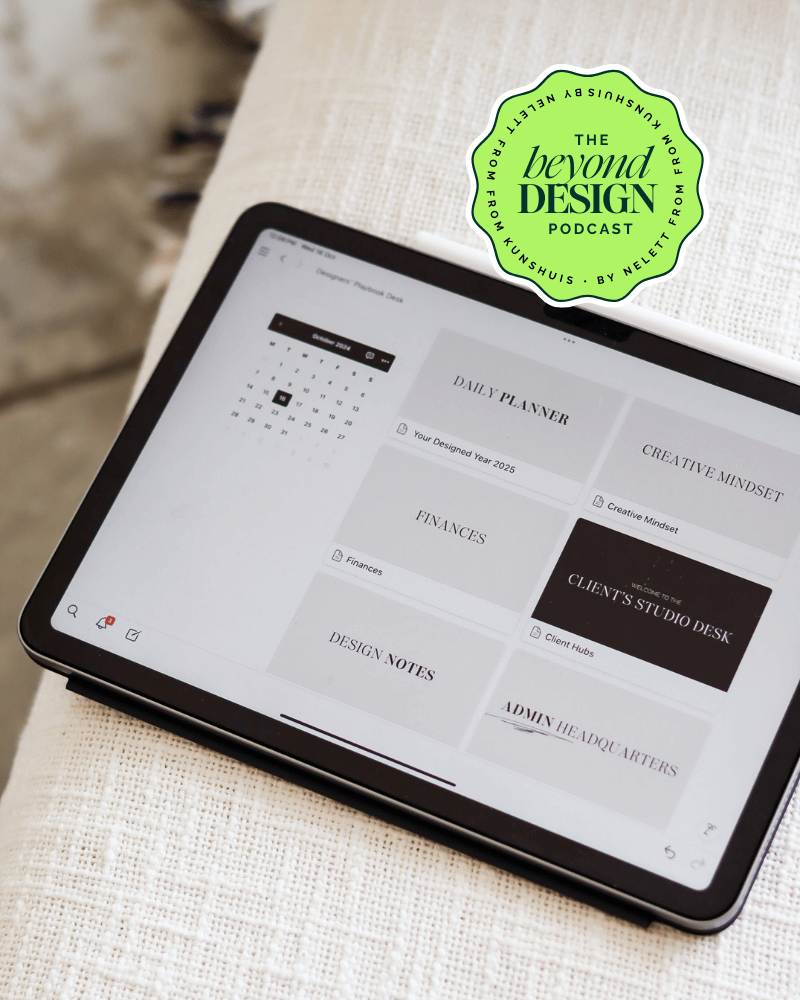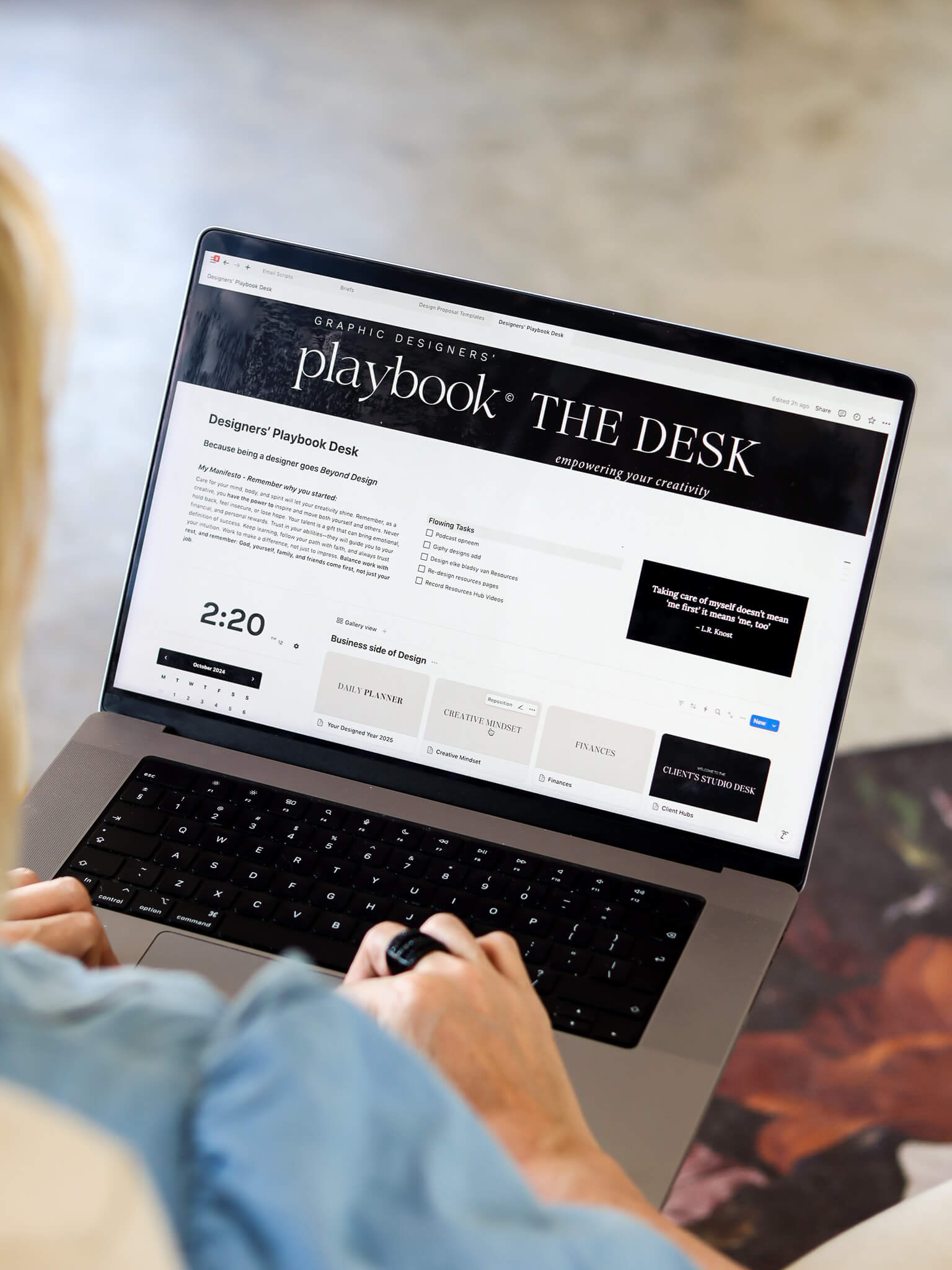
Listen on APPLE PODCAST | SPOTIFY
Hey friend,
Let’s talk about money.
Yes… that awkward, sweaty-palms topic that can make the most confident designer suddenly question everything. How much do I charge? Is this too much? Am I overthinking it?
Honestly—if you’ve ever stared at a quote and thought, “What even is the right number?” — you’re not alone. I’ve been there. Still visit that place sometimes.
Even now, 16 years into freelancing, pricing still shows up like a tricky muscle that needs stretching. But here’s what I’ve learned:
Your price isn’t just a number. It’s a reflection of how you see yourself. A signal of your energy, your boundaries, your belief in your work.
So let’s pull this one apart, gently. Let’s make pricing feel less scary—and more like something that can work for you, not against you.
My Early Pricing Story (Spoiler: it was a bit of a mess)
When I started freelancing, my pricing strategy was… vibes. R300 for a logo. R800 if I was feeling brave.
No spreadsheet. No plan. Just a mix of gut feelings and not wanting to feel “too expensive.”
And then one day, a client said something that stopped me:
“I didn’t expect to get all this for that price.”
At first, I smiled. I felt proud. But later that night, I realised… I had over-delivered and undercharged. Again.
I had stayed up late, skipped dinners, done research, design, revisions—and still, I wasn’t charging what the project actually cost me in time and energy.
That’s when I realised: I wasn’t running a business. I was just trying to be affordable. And it was burning me out.
So I sat down—with my silent business partner (my husband)—and we started unpacking it. One quote. One tender. One project at a time.
The Truth About Pricing
Here’s something I wish someone told me sooner:
Pricing isn’t math. It’s clarity.
Clarity around:
- Your time
- Your process
- Your value
- Your energy
You don’t need to be a finance expert. But you do need a structure that honours what you offer.
Let’s walk through a few pricing models I’ve tested (and still use), so you can decide what works best for you.
1. Hourly Pricing
This is how a lot of us start out.
How it works: You charge per hour of work.
✅ PROS: Easy to track, great for admin tasks or one-off jobs.
❌ CONS: It punishes efficiency. And it doesn’t honour your 10+ years of experience or the time you spend thinking.
I still use hourly rates when a job is small or open-ended. But it’s not my go-to anymore.
2. Project-Based Pricing
How it works: You quote a set fee for a defined scope.
✅ PROS: Clear for you and the client. Everyone knows what to expect.
❌ CONS: If you underestimate your time or scope—oof. It eats into your energy and profit.
What helped me? Creating quote templates with tiered options. Example: Option 1: simple branding Option 2: branding + stationery Option 3: full branding suite with strategy
Having those ready saves time and gives me confidence. (There’s a quote template in the Playbook Desk if you need one.)
3. Design Days / VIP Days
One of my favourite models for small jobs.
How it works: A client books you for a full day (or half). You both commit to getting the work done that day. At the end of the day, they pay. Done.
✅ PROS: No long timelines. Full focus. No back-and-forth.
❌ CONS: You need a system and prep. It’s not for full branding jobs.
Playbook Desk users—you’ve got a full Design Day Kit inside. From prep lists to email scripts.
4. Retainers
Perfect for long-term relationships, if done right.
How it works: Clients pay a monthly fee for consistent support.
✅ PROS: Predictable income. Easier planning.
❌ CONS: Can become blurry. “Quick favour” territory.
My advice? Always review every 3 months. Be crystal clear about what’s included (and what’s not). For example, my client’s daily comms are on retainer—but the Annual Report is a separate quote.
5. Value-Based Pricing
This is where things get powerful.
How it works: You price based on the value your work creates—not the time it takes.
✅ PROS: You’re paid for your impact.
❌ CONS: It requires confidence, and clients who get it.
If your rebrand helps a client land R200K in contracts… charging R20K is not outrageous. It’s aligned.
This is the model I lean into now. But it took time. If you’re not there yet—that’s okay. Start where you are.
Pricing Isn’t Just Numbers—It’s Mindset
Let’s be honest. Pricing is emotional.
It brings up everything we were taught about money growing up: What’s “too much.” What’s “fair.” What’s “allowed.”
But here’s a truth I want you to hold:
You are allowed to make money without guilt. You are allowed to be generous without self-abandoning. You are not too expensive. You don’t owe anyone an essay to explain your rate.
This is the deep work. And it’s why I created the Playbook—to hold your hand through the admin and the emotional parts of creative work.
What About Free Work?
Not all free work is bad.
Sometimes I offer something as a gift to a client. But it’s always on my terms.
I never agree to do work “for exposure.” And I don’t give discounts unless something in the scope changes.
Sometimes, if a corporate client wants a discount for a big project, I price it normally—then show a discount. It’s a visibility thing. But I still get paid what I need.
Generosity is beautiful.
But depletion is not your brand.
The Systems That Hold You
Pricing confidence doesn’t come from shouting your rate. It comes from having a system that backs you.
Inside the Playbook Desk, you’ll find:
- Quote templates
- Scope breakdowns
- Payment schedules
- Invoice copy
- Rush fee policies (P.S. mine is 25%)
- Revision limits
- Client scripts and boundaries
This isn’t boring admin. It’s the backbone of your peace.
Let’s Wrap It Up
If this feels like a lot—breathe.
You don’t need to fix it all today.
But maybe you try one tiny move:
- Redo your quote template.
- Say “That’s outside scope” without flinching.
- Try a Design Day.
- Or just revisit what you need to feel supported when you price.
Pricing is power. And your work deserves to be valued.
Thanks for reading, friend.
And if you need the tools to support what I just shared—go peek inside the Playbook. It’s all there. Quietly waiting to hold you, like a business partner who doesn’t talk too much.
Until next time, Design your life, wherever you are. 🖤


